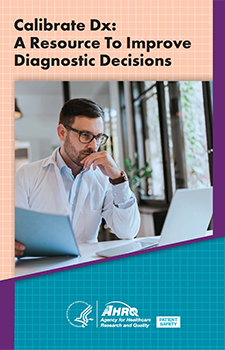Delayed, wrong, and missed diagnoses are major contributors to patient harm. Lifelong learning is essential for achieving and maintaining diagnostic excellence. Diagnostic excellence involves not just making a correct and timely diagnosis but also doing so while using the fewest resources necessary, optimizing patient experiences, and managing uncertainty. The Agency for Healthcare Research and Quality has developed Calibrate Dx to provide clinicians with guidance for evaluating and calibrating diagnostic performance for the purposes of learning and improvement.
Calibrate Dx is designed to be used by individual licensed clinicians, but it may also be of interest to healthcare organization leaders, quality and safety personnel, educators, and trainees. This tool provides practical recommendations for implementing calibration strategies that can be applied in operational settings.
About the Resource
The Calibrate Dx Guide (PDF, 27 MB) is organized into five sections that guide the user through the calibration concepts and exercises:
- Part 1: Introduction to calibration and overview of the calibration exercise.
- Part 2: Specification of the calibration tasks, based on areas that are important to each clinician's clinical practice, and formulation of questions to guide the calibration exercise.
- Part 3: Guidance for evaluating diagnostic performance, including case selection for review and reflection and use of the Diagnostic Calibration Debrief Tool.
- Part 4: Planning and application of improvement strategies, based on information gleaned from case reviews and debriefs with colleagues. Guidance on reflecting on diagnostic performance over time and adjustment of Calibrate Dx use is provided at the end of the resource.
- Appendixes with materials that facilitate calibration exercises.
Additional Materials To Assist With Startup and Implementation
- Clinician's Quick-Start Guide to Calibrate Dx (PDF, 294 KB). This one-page document provides guidance to clinicians about the purpose of Calibrate Dx and how to start using the resource.
- Guide for Clinical Leaders (PDF, 280 KB). This two-page document is intended for clinical leaders and describes four steps to successfully implement Calibrate Dx: Prepare, Make a Plan, Implement Resource, and Evaluate and Iterate.
- Diagnostic Calibration Debrief Tool (PDF, 202 KB). This fillable tool assists with planning case reviews and reflecting on clinical reasoning across cases. The tool also appears in Appendix A of the Calibrate Dx Guide.
- Revised Safer Dx Instrument (PDF, 213 KB). Fillable version of a validated tool consisting of 13 items that prompt review of the diagnostic process. The tool also appears in Appendix B of the Calibrate Dx Guide.
Acknowledgments
The development of this tool was led by the Center for Innovations in Quality, Effectiveness, and Safety, Michael E. DeBakey Veterans Affairs Medical Center and Baylor College of Medicine, Houston, Texas, under the direction of Andrea Bradford, Ph.D., Ashley N.D. Meyer, Ph.D., and Hardeep Singh, M.D., M.P.H., with support from the MedStar Institute for Quality and Safety.
The resource was developed in collaboration with a team of subject matter experts who contributed recommendations and content. Contributors' names and affiliations are listed in the front of the Guide.
Email Andrea Bradford with questions.




